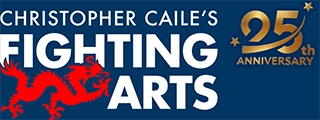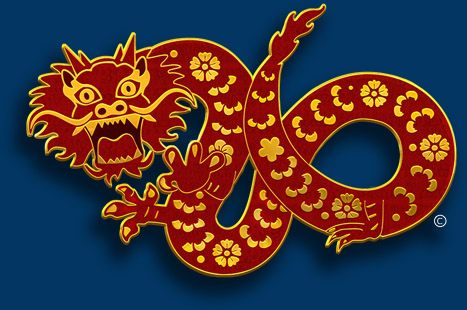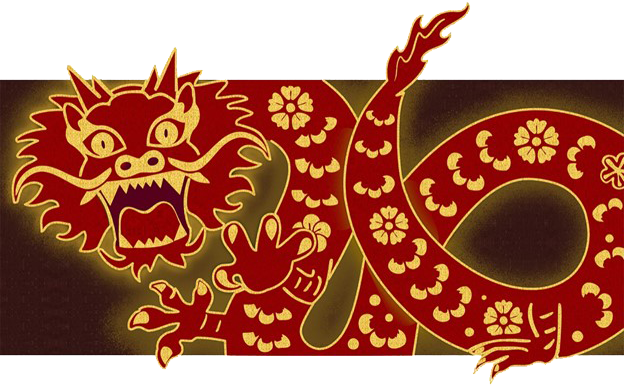Treasure Of '70's Film Footage Recovered: Includes Elvis Sponsored Karate Film
By Christopher Caile

Raw movie footage, including an unreleased karate documentary financed by Elvis Presley, sat in the back of an old pickup truck in Hollywood, California, for 14 years.
There in the dusty, open back of the truck inside of a garage sat boxes of reels – a thousand-plus hours of classic karate and other footage dating back to the mid-1970's. There was the karate documentary, "The New Gladiators," financed but never released by Elvis's film production company. The film had been produced by George Waite, a well known karate practitioner, entrepreneur, and friend of Elvis's. There was also 32 minutes of Elvis himself demonstrating karate, a pristine color print of one of Bruce Lee's famous demonstrations, and other footage showing such music greats as David Crosby, Graham Nash and Steven Stills.
 |
Don Warrener |
"We still haven't viewed all of it yet," says Don Warrener, who rescued the footage and is now promoting it. "But what we have found so far is an unbelievable treasure trove. It just sat there all this time. Now the world can enjoy it." Warrener is the founder of the video production and distribution company Rising Sun Productions, based in Los Angeles. He is also a well known Goju-ryu karate practitioner and author of several books on karate.
How the "New Gladiators" film and other footage was recovered is a story in itself.
A couple of years ago Warrener invited a friend of his, Joe Hyams, to his office. Hyams is well known for his promotion of karate in Hollywood, and is the author of the books, "Zen And The Martial Arts," and "The Journey." He brought with him George Waite and and another friend, Emil Farkas. Farkas was a martial arts author and TV and movie karate consultant. Both Waite and Hyams were students of the famous karate pioneer Ed Parker and had trained together for years.

There were more meetings, and still Waite would only say, "I don't want to talk about the film."
It took about a year and one half and four meetings before Warrener got through. "Warrener gave me some videos he had produced for other martial artists. They were quite good and I was impressed," said Waite. Waite then promised several times to bring the film in, but never did. At long last, Warrener took action.
At their next meeting Warrener relates, "I said, What are you doing now? Do you have time?" And soon Waite found himself bundled into Warrener's car headed toward Waite's home in West Hollywood.
Behind Waite's house was a garage. They pushed away a vehicle that sat in front of the garage door and entered. "It was full of stuff," said Warrener. "It looked like he never threw anything away. And in the corner was an old 1963 GMC pickup van, and in the back, boxes and boxes of film reels."
Warrener started loading boxes of film reels into his car. Waite said, "You should take this, it's a film of Elvis doing karate." Then he said, "Here, take this too, it's a film of Bruce Lee." He also got the rough footage of a documentary karate film that Warrener has now released under its original name, "New Gladiators."
The idea for this documentary karate film came to Waite in 1972 or 1973.
"I got the idea for the film when watching the end of a football game," said Waite. "There were shots of the trash being picked up, and of the athletes dressing. There were more shots of the players traveling to the next game and of them getting ready. It reminded me of going to karate tournaments." Following a group of karate competitors through their training and then their competition from tournament to tournament could make a great film, he reasoned.
The idea was to produce a documentary that would show real karate, with its discipline and the excitement of competition.
During this time Bruce Lee and Kung Fu had exploded into public attention. Lee had been featured in several TV shows and movies which culminated in the release of the movie classic, "Enter The Dragon," in 1972. His and other Kung Fu movies featured flashy, movie-style techniques.
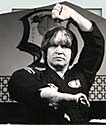 |
Ed Parker |
Waite took his idea to his teacher, Ed Parker, the famous karate pioneer, founder of Kenpo karate who had become a Hollywood celebrity. "We had just finished a video commercial. Parker was advertising his Long Beach International Tournament. So, I showed Parker the concept. I was actually thinking about him for the film, but he picked up the phone and called Elvis," said Waite.
Parker was a close friend of Elvis and his karate teacher. His association with Elvis also helped catapult Parker and his Kenpo Karate into national prominence.
Elvis had been introduced to karate in Germany while in the military. He started studying the art there. Back in the US, he continued training. In his book "The Journey," which profiles Elvis's Kenpo history, Hymas notes that in 1960 Elvis's wrote his German karate instructor, Jurgen Seidel, about his desire to promote karate through film. Hymas notes that "a decade before Bruce Lee and David Carradine brought martial arts to the big and small screens, Elvis recognized that his use of karate brought a unique element to his onscreen presence." A decade later Parker helped Elvis, who was then his student, incorporate karate movement into his stage presentations.
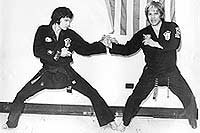 |
Elvis Presley with Ed Parker |
Elvis loved the art, and constantly surrounded himself with martial artist friends. "Elvis had trained with Ed Parker regularly," said Waite. "In fact he was really quite good. Elvis had one unusual quality: he did not feel physical pain and this made him part of the karate guys so to speak. In Elvis's last days, only his karate friends were present and he really felt close to them. It was they he trusted."
In 1974 Parker awarded Elvis an eighth degree black belt in Kenpo karate. Karate also bled over into how Elvis staged his concert presentations. He also demonstrated karate in many of his films. After receiving a number of threats on his life in 1972, Elvis intensified his training and hired one of Parker's black belts as the first of his karate trained bodyguards.
Back to the story: Parker took Waite to Elvis's house in Beverly Hills at 5 pm. Elvis was just getting up and was dressed in pajama bottoms, covered with a karate uniform top with a robe over it. They sat at the dining room table, and "I talked to him about my idea. I had a two page summary of the concept and some sketches," said Waite.
"We also talked about how Elvis would participate and decided he could narrate and give a demonstration," Waite said. Apparently Elvis had seen promotional TV shots Waite had made for Parker and asked "Can you make me look like that?"
Elvis liked the idea for the film, said Waite, but said he was going to Las Vegas for a show the next morning, and he would think it over.
The next day Waite received a call from Elvis. Elvis asked Waite and his girlfriend to come to Vegas as his guest. Waite took a commercial flight and Elvis sent his private plane to pick up Waite's girlfriend, who was in another city.
That evening they attended Elvis's show and sat on the far right end of the stage during his performance at the Las Vegas International Hilton. At the end of the show Elvis talked to the audience about his new karate film and then introduced Waite to the audience as the film's producer. He also introduced other guests including Charlton Heston.
A private penthouse party followed with Bill Bixby, Charlton Heston, Mort Sahl and others. Elvis entertained with a short karate demonstration and then asked Waite to take over. "I had just finished a series of demonstrations with Parker," said Waite, "so a demonstration was easy for me."
"Elvis then took me aside," says Waite, "and wrote out a check for $50,000. He told me to take the check downstairs and get it cashed so I could start the project immediately." Waite estimates that the film was produced for the bare-bones cost of approximately $200,000. The participants were not paid, and many people volunteered their time. They decided to call the film "New Gladiators."
The film follows a team of five American fighters who took on the challenge of the best karate fighters in the world. The film was shot over a year and one half period. Team members included Darnell Garcia, Tom Kelly, Ron Marchini, John Natividad, and Benny Urquidez. Parker and Waite led the team.
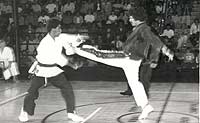
Ralph Alagrea fighting Cecil Peoples

Steve Sanders who fought in the Beverly Hills tournament

Benny "The Jet" Uriquidex against John Natividad
They traveled first to England to fight with the best Great Britain had to offer, and then to Belgium to fight Europe's best in late 1974. The film follows their return to the US to fight in tournaments in Long Beach and then Oakland. It ends with the final match between Roy Kurban (now a judge in Texas) and Benny "The Jet" Urquidez. It is one of classic matches of all times in sport karate.
"There is some truly great action. The competitors were some of the most talented of our time," says Waite. "In the 1970's there was no safety equipment and competition was also rough and tumble. Fights were hard and there was a lot of contact."
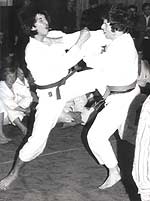 |
Belguim's Gert Lemmens |
In one film segment, America's Ron Marchini gets his face split open with a strike from the Belguim team captian Geert Lemmens. In another segment US Champion Dan Anderson is seen receiving a front kick to the face, in slow motion, which levels him.
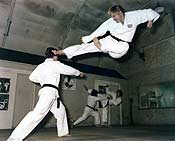 |
Ticky Donovan |
The film also features other great martial artists of the era — Ed Parker, Eric Lee, Mike Stone, Roy Kurban, Emil Farkas — as well as international fighters, such as England's Ticky Donovan, and many others.
George Waite produced the film and it was directed by Robert Hammer. They enlisted some of the best available talent at that time for this film. Participating were names like Allen Davio and John Hora, who went on to win an Academy Award for cinematography. And the music score was written by David Crosby and Graham Nash, who were part of the legendary quartet Crosby, Stills, Nash, and Young.
Elvis contributed custom-made red, white and blue karate uniforms for the team. They were flown in from Japan.
In January or February of 1974, Waite relates, Elvis called from Memphis to get a film crew to cover him giving awards and a demo. "We didn't have a crew available but flew to Graceland where Elvis handed me a 16 millimeter film of his performance. After looking at it hard, however, we decided it was not suitable for the film."
"New Gladiators' was never really finished," relates Waite. The original 40 hours of film we shot had been edited down to four hours of rough takes and shown to Elvis, and later edited down again to two hours. "Bob Hammer and I spent nearly a year editing it down," said Waite.
"Elvis thought that was good enough," Waite continued. "He then wanted us to produce a racket ball film. In one day he flew us to Florida, Dallas and Back to Memphis to look at matches, but we didn't pursue this further."
In a 1977 interview with Inside Kung Fu magazine (quoted in Hymas book), Waite said that the film was something that Elvis had wanted to do for years – a film of him and karate and what it was all about, not a Bruce Lee like film with a lot of flash, high kicks and jumps.
Unfortunately, however, Elvis's demo was never re-shot. It was difficult to coordinate with Elvis's schedule, and he gained a lot of weight. Then he died not long afterward.
"After Elvis's death, I just lost interest," said Waite. "I had liked Elvis a lot and when he died I felt a great sense of personal loss. Elvis was also the heart and soul and driving force behind the project as he called us nearly every day to see how the progress was coming along. He really was deeply involved in the project since he loved martial arts and would do anything to promote it."
As a result, the film was never finished. It sat in storage, and then Waite took the footage home and stored it in the back of his pickup truck where it sat for the next 14 years.
After Warrener recovered the film, it was edited, cleaned up and converted to video and DVD format and released. It's 93 minutes long.
As to the 32 minutes of raw Elvis Presley footage of him demonstrating karate (which was never incorporated into "New Gladiators"), as well as a 16mm color print that contains 8.5 minutes of Bruce Lee demonstrating and free sparring at the 1967 Ed Parkers Long Beach International Tournament, Warrener is still looking into possible projects for their release.
The Elvis footage shows him demonstrating both technique and self-defense. He also shows his tolerance to pain. Red West is shown pushing against Elvis's throat. Elvis is also shown absorbing punches to the gut. This Elvis footage also contains a presentation given to Bill Wallace by Elvis accompanied by Linda Thompson. There are also shots of Wallace demonstrating his kicking skills.
"There is still a lot of the discovered footage that remains to be viewed," said Warrener. I think there is also footage of David Crosby, Graham Nash and Steven Stills. Also there is a possibility of Jimi Hendrix footage as well."
"This continues to be a great adventure," said Warrener.
|
Now buy the "New Gladiators" video from
|
Acknowledgement:
FightingArts.com wants to thank both Don Warrener and George Waite for the interviews that contributed to this article. We also appreciate Warrener's provision of the many photos that appear in this article.
About the Author Christopher Caile
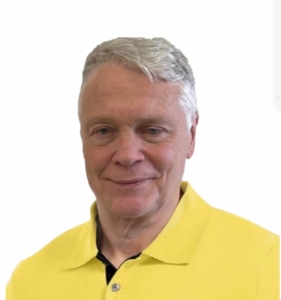
Screenshot
Christopher Caile is the Founder and Editor-In-Chief of FightingArts.com. He has been a student of the martial arts for over 65 years.
He first started in judo while in college. Then he added karate as a student of Phil Koeppel in 1959 studying Kempo and Wado-Ryu karate. He later added Shotokan Karate where he was promoted to brown belt and taught beginner classes. In 1960 while living in Finland, Caile introduced karate to that country and placed fourth in that nation's first national judo tournament.
Wanting to further his karate studies, Caile then hitch hiked from Finland to Japan traveling through Scandinavia, Europe, North Africa, the Middle East and South and Southeast Asia — living on 25 cents a day and often sleeping outside.
Arriving in Japan (1962), Caile was introduced to Mas Oyama and his fledgling full contact Kyokushinkai Karate by Donn Draeger, the famous martial artist and historian. Donn also housed him with several other senior international judo practitioners. Donn became Caile's martial arts mentor, coaching him in judo and introducing him to Shinto Muso-ryu under Takaji Shimizu.
Caile studied at Oyama's honbu dojo and also at Kenji Kurosaki's second Tokyo Kyokushinkai dojo. In his first day in class Oyama asked Caile to teach English to his chief instructor, Tadashi Nakamura. They have been friends ever since. Caile also participated in Oyama's masterwork book, "This Is Karate."
Caile left Japan with his black belt and designation as Branch Chief, the first in the US to have had extensive training in Japan directly under Oyama Sensei. As such, Oyama Sensei asked him to be his representative on visits to his US dojos to report on their status.
A little over a year later, Nakamura, Kusosaki and Akio Fujihira won an epic David vs. Goliath challenge match against Thailand's professional Muay Thai Boxers in Bangkok, Thailand, thrusting Kyolushinkai and Nakamura into national prominence.
Back in the US Caile taught Kyokushinkai karate in Peoria, Il while in college and later in Washington, DC. while in graduate school. Durimg this time Shihan Nakamura had moved to New York City to head Kyokushinkai's North American Operation.
In 1976 when Kaicho Tadashi Nakamura formed the World Seido Karate organization, Caile followed. Living then in Buffalo, NY, Caile taught Seido karate and self-defense at the State University of New York at Buffalo (SUNY Buffalo) for over 15 years where he also frequently lectured on martial arts and Zen in courses on Japanese culture.
Caile moved to New York City in 1999 to marry Jackie Veit. He is now an 8th degree black belt, Hanshi, training in Seido Karate's Westchester, NY Johshin Honzan (Spiritual Center) dojo. In Seido Caile is known for his teaching of and seminars on kata applications. He also produced a 14 segment video series on Pinan kata Bunkai currently available to Seido members.
Caile is also a long-time student and Shihan in Aikido. He studied in Buffalo, under Mike Hawley Shihan, and then under Wadokai Aikido's founder, the late Roy Suenaka (uchi deshi under Morihei Ueshiba, founder of Aikido and was Shihan under Tohei Sensei). In karate, Suenaka (8thdan) was also an in-house student of the Okinawan karate master Hohan Soken.
Having moved to New York City, Caile in 2000 founded this martial arts educational website, FightingArts.com. Twenty-five years later, in 2025, it underwent a major update and revision.
For FightingArts.com and other publications Caile wrote hundreds of articles on karate, martial arts, Japanese art, Chinese Medicine and edited a book on Zen. He also developed relationships with a cross section of leading martial arts teachers. Over the last four decades he has conducted extensive private research into karate and martial arts including private translations of the once secret Okinawan hand copied and passed on Kung Fu book, the Bubishi, as well as an early karate book by the karate master Kenwa Mabuni. He periodically returns to Japan and Okinawa to continue his studies and participate Seido karate events. In Tokyo he practiced (with Roy Suenaka Sensei) in a variety of aikido organizations with their founders – including private interviews and practices at the Aiki-kai Aikido Honbu dojo with the son and grandson of aikido's founder, Doshu (headmaster) Kisshomaru (an old uchi-deshi friend) and his son, Moriteru Ueshiba and in Iwama with Morihiro Saito. On Okinawa he studied Goju Ryu karate under Eiichi Miyazato, 10th dan founder of Naha's Jundokan, and also with Yoshitaka Taira (who later formed his own organization, who specialized in kata Bunkai. While there Caile also trained with Hohan Soken's senior student, Master Fusei Kise, 10 dan as well as with the grandson of the legendary karate master Anko Itosu.
Caile's other martial arts experience includes: Diato-ryu Aikijujitsu and Kenjitsu, kobudo, boxing, Muay Thai, MMA, Kali (empty hand, knife and bolo), study of old Okinawan Shoran-ryu & Tomari body mechanics, study of old Okinawan kata under Richard Kim, study of close quarter defense and combat, including knife and gun defenses, Kyusho Jitsu and several Chinese fighting arts including 8 Star Praying Mantis, Pak Mei (White Eyebrow), and a private family system of Kung Fu.
Caile is also a student of Zen as well as a long-term student of one branch of Traditional Chinese Medicine, Chi Kung (Qigong). As one of two senior disciples of Chi Kung master Dr. Shen (M.D., Ph.D.) Caile was certified to teach and practice. This led to Caile's founding of the The Chi Kung Healing Institute on Grand Island, NY. In Western NY, he also frequently held Chi Kung seminars, including at SUNY Buffalo and at the famous Chautauqua Institution in Chautauqua, NY. His articles on Chi Kung also appeared in the Holistic Health Journal and in several books on alternative medicine.
Caile holds a BA in International Studies from Bradley University and MA in International Relations with a specialty in South and Southeast Asia from American University in Washington, D.C. While in Buffalo, NY he also studied digital and analog electronics.
In his professional life Caile also worked in public relations and as a newspaper reporter and photographer. Earlier he worked in the field of telecommunications including Managing a Buffalo, NY sales and service branch for ITT. He then founded his own private telephone company. This was followed by creation of an electrical engineering company that designed and patented his concept for a new type of low-cost small business telephone system (which was eventually sold to Bell South). The company also did contract work for Kodak and the US space program. Simultaneously Caile designed and manufactured a unique break-apart portable pontoon boat.
Most recently Caile co-founded an internet software company. Its products include software suites with AI capability for control and management of streaming media, such as video and music, an all-in-one book publishing software product for hardcover, eBook and audio book creation and security software for buildings and government use.
For more details about Christopher Caile's martial arts, work experience and life profile, see the About section in the footer of this site.
Search for more articles by this author:
